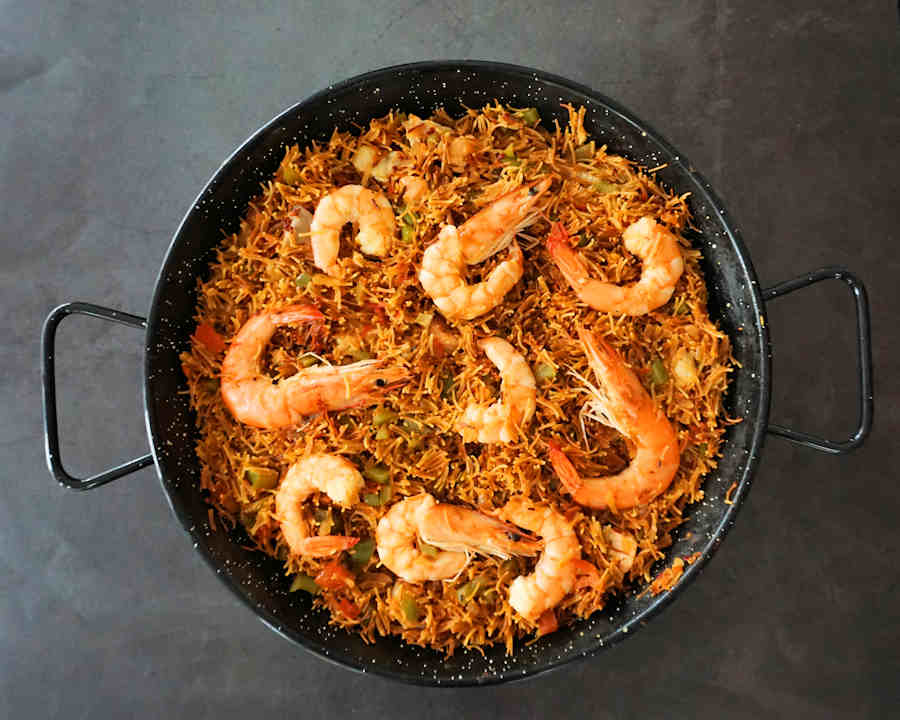Fideua, just like paella, is a classic summer dish cooked convivially over a barbecue in a special huge pan, shared between friends or family. Except it’s pasta instead of rice.

What is fideua?
Fideua is a paella with pasta instead of rice. It sounds like an attempted improvement on a perfection, doesn’t it? What can be better than paella, cooked in an enormous dish, with prawns and mussels or chicken and chorizo, with the gorgeous, near-burnt soccarat stuck to the bottom of the pan?
All that, plus pasta, is the assumption. So is it indeed an improvement? Can you swap rice and pasta willy—nilly? Or are some things made this way not the other for a reason, and you shouldn’t fix what’s not broken?
Of course, it’s not fixing; fideua is a Spanish dish in its own right. The story goes a cook for a fishing boat replaced rice in his paella with vermicelli noodles to spite the greedy skipper who never left enough paella for his mates. I do love those stories.
But fideua is significantly less popular than paella. Pasta might be more expensive in Spain than rice which grows there abundantly as the ignorant me was astonished to learn. But perhaps that’s not the only reason and rice simply works better? That’s what I set out to find out.
Fideua or paella: which is better?
I have my trusted paella recipe and from what I could see out there, fideua is made in the same way: meat or fish, aromatics, flood the pan with stock and scatter the rice/pasta all over – completely counter-intuitively. And if it sticks, that means you’re masterful as soccarat, the crisp bottom layer of rice, is a delicious elusive effect to get right.
So let me start at the end: no soccarat in fideua. None, zip, diddly squat. That’s paella one, fideua nil. I like my soccarat.
The cooking method is as easy and takes as long so it makes it one all. But for fideua the seafood needs to be pre-cooked before it returns to the pan at the end of the cooking: that’s because there is no soccarat-developing, rice-popping last ten minutes’ spell. Once the pasta is cooked, that’s it.
Everything comes down to the soccarat it seems! But as you need to sear your prawns and fish, steam your mussels and clams beforehand – it’s hassle. More bother.
Finally – the taste. I enjoyed it, The Weather Man less so, and we didn’t polish the enormous, 4-people pan between us as we usually do with paella. So that’s the conclusive answer: it ain’t quite paella.
It is delicious as a variant. But it’s more like a semolina porridge instead of oats for breakfast: nice and a bit different every once in a while, but the oats are never beaten.
How to make fideua
It is an easy and pleasant cooking session, at least in my view. The only spot of a chore is making the stock out of prawn shells and heads. It isn’t strictly necessary – a fish or vegetable stock cube is serviceable – but it does make a difference to the taste and flavour. Your choice.
The toasting of the pasta is also optional, but likewise adds to the taste. I know, we don’t toast spaghetti for carbonara, but this is an entirely different pasta cooking method and so the toasting is fully legit. Don’t toast it if you can’t be bothered.
Either way, the fish and seafood need to be seared and precooked, in the paella pan or the largest frying pan you own, after the toasted pasta has been removed.
The seafood goes off the pan and now it’s all straightforward: cooking the vegetables and aromatics with a little olive oil, adding spices, and if you took the trouble with the prawn stock, it will be ready to be strained into the pan by then.
Following that the pasta is sprinkled over the stock, totally not like your Nonna taught you. When it absorbs all the liquid, the seafood returns to top the dish or half-buried in the fideos. After a couple of minutes, it’s all ready – bar the soccarat. And yes, I’ll now shut up about the blasted soccarat. Buen Provecho!